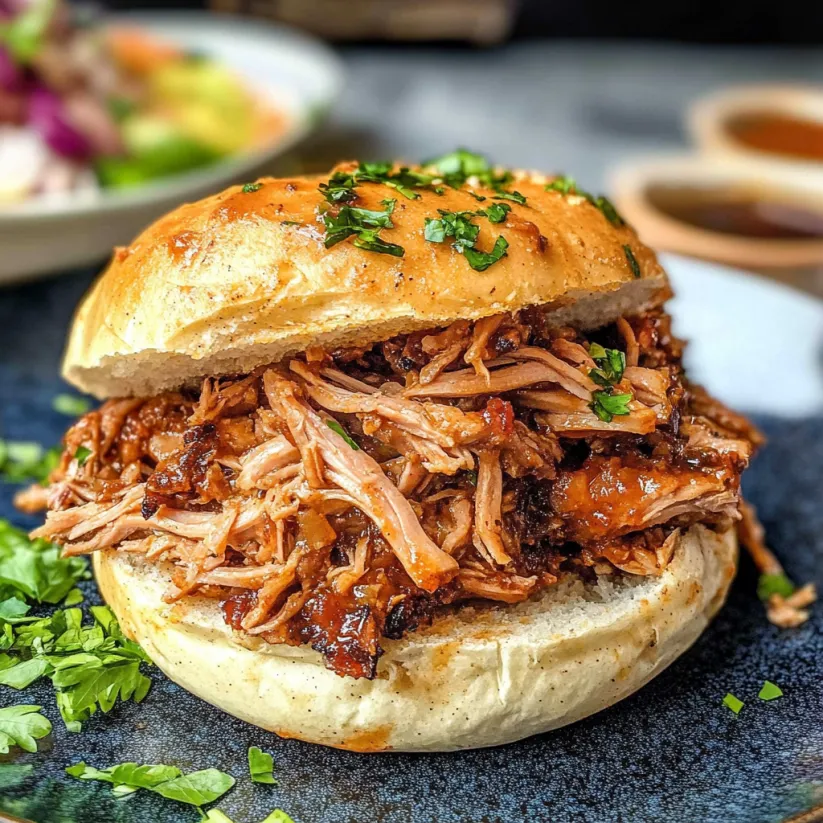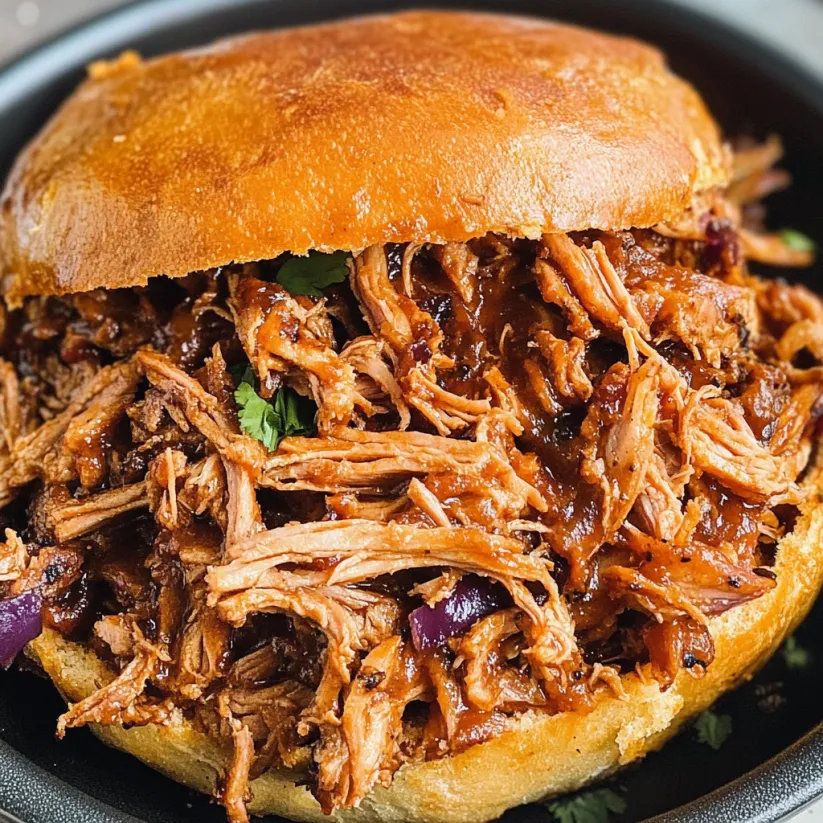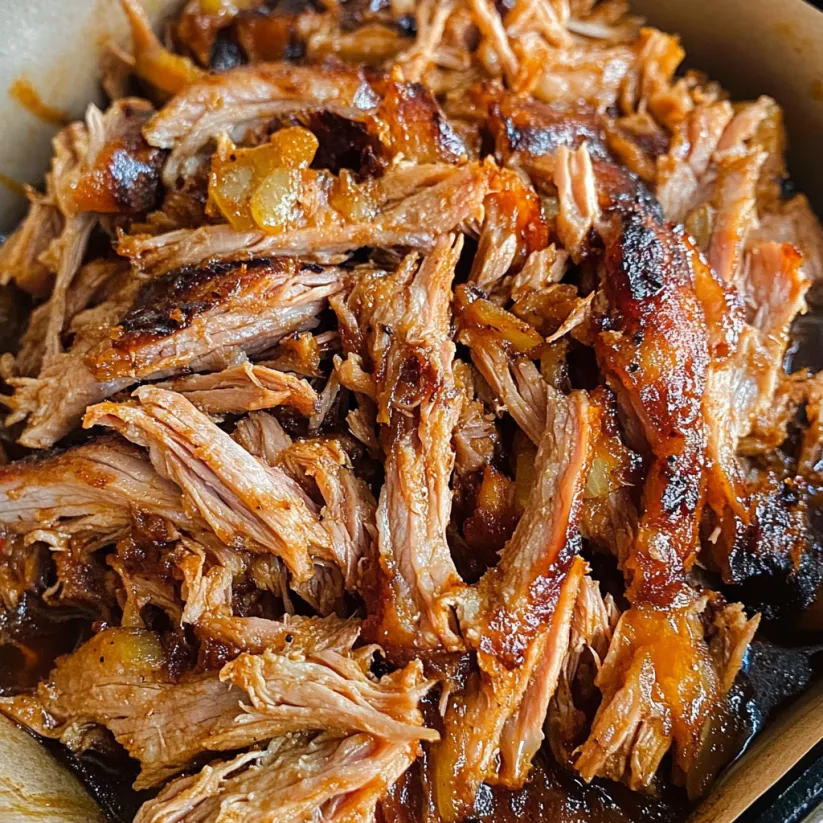 Save Pin
Save Pin
This succulent pulled pork recipe transforms an ordinary pork shoulder into a mouthwatering masterpiece through slow roasting and careful seasoning. The result is tender, flavorful meat that pulls apart effortlessly and works wonderfully in sandwiches, tacos, or simply enjoyed on its own.
I first made this pulled pork for a summer backyard gathering and watched as guests returned for seconds and thirds. Now it's my go to dish whenever I need to feed many hungry people with minimal fuss but maximum flavor impact.
Ingredients
- Pork shoulder The star of the show. Look for a well marbled cut with the bone in for maximum flavor
- Ground cumin Adds an earthy warmth that forms the foundation of the spice blend
- Garlic powder Provides that essential savory note without having to chop fresh garlic
- Onion powder Creates depth of flavor without the texture of actual onions
- Chili powder Contributes a mild heat and beautiful color
- Cayenne pepper Brings the heat. Adjust according to your spice preference
- Salt Essential for enhancing all other flavors. Use kosher salt for best results
- Black pepper Adds a subtle spiciness that balances the sweetness
- Paprika Provides beautiful color and a subtle smokiness
- Brown sugar Creates caramelization and balances the spices with sweetness
- Bay leaves Adds an herbal complexity to the brine
Step by Step Instructions
- Create the dry rub:
- Combine cumin, garlic powder, onion powder, chili powder, cayenne pepper, salt, black pepper, and paprika in a bowl. Add brown sugar and mix thoroughly until completely incorporated. The mixture should be fragrant and uniform in color.
- Prepare the brine:
- In a large pot, dissolve salt and brown sugar in cold water. Add three tablespoons of your prepared dry rub and stir until completely dissolved. The brine should taste noticeably salty but not overwhelmingly so.
- Brine the pork:
- Submerge your pork shoulder completely in the brine solution along with bay leaves. Cover and refrigerate overnight or for at least 8 hours. The brine works to both season the meat deeply and alter its protein structure for maximum tenderness.
- Prepare for roasting:
- Remove pork from brine and pat thoroughly dry with paper towels. Place in a deep roasting pan. Massage the remaining dry rub generously over the entire surface of the meat, pressing it into every crevice. Let the meat sit at room temperature for about 30 minutes while you preheat your oven to 225°F.
- Slow roast:
- Add two cups of water to the bottom of the roasting pan, being careful not to wash away the rub. Place the pan on the middle rack of your preheated oven. Roast low and slow for approximately 12 hours, until the internal temperature reaches 200°F and the meat feels tender when probed with a fork.
- Rest the meat:
- Remove the pork from the oven and cover loosely with foil. Allow it to rest for 1.5 to 2 hours. This resting period is crucial as it allows the meat fibers to relax and reabsorb juices, resulting in moister meat.
- Shred and serve:
- Using two forks, pull the meat apart into shreds. The meat should separate easily with minimal effort. Discard any large pieces of fat. If desired, mix in some of the cooking juices from the pan to enhance moisture and flavor.
 Save Pin
Save Pin
The brown sugar in this recipe is my secret weapon. It not only balances the spices but creates a beautiful caramelization on the outside of the pork. I learned this trick from my grandfather who was known in our family for his barbecue skills. He always said the mark of great pulled pork wasn't just tenderness but that perfect balance of sweet and savory.
Best Meat Selection Tips
Choosing the right cut of pork is fundamental to this recipe's success. Look for a well marbled pork shoulder with the fat cap intact. This marbling melts during the long cooking process, basting the meat from within and preventing it from drying out. While boneless cuts work fine, bone in shoulders typically yield more flavor. The meat should have a pinkish red color and feel firm to the touch. If possible, source your pork from a local butcher who can tell you about the meat's origin. Pasture raised pork often has superior flavor due to the varied diet of the animals.
Storage and Reheating
Pulled pork actually improves in flavor after a day in the refrigerator, making it perfect for meal prep. Store cooled pulled pork in airtight containers for up to 4 days in the refrigerator. For longer storage, portion the meat into freezer bags, removing as much air as possible before sealing. When ready to reheat, thaw overnight in the refrigerator if frozen. The best reheating method is to place the meat in a covered dish with a splash of water, apple juice, or broth to maintain moisture, then warm in a 300°F oven until heated through. Avoid microwaving if possible as it can make the meat tough.
Serving Suggestions
This versatile pulled pork shines in countless applications. For classic pulled pork sandwiches, pile it high on brioche buns with coleslaw and pickles. Use it as a filling for tacos with avocado, cilantro, and lime. Add it to mac and cheese for a hearty main dish. Layer it in breakfast hash with potatoes and top with a fried egg. For a lower carb option, serve it over a salad with a vinaigrette dressing that cuts through the richness. No matter how you serve it, consider offering a selection of BBQ sauces on the side from sweet to tangy to spicy to accommodate different preferences.
Regional Variations
This pulled pork recipe draws inspiration from several American barbecue traditions. In North Carolina, pulled pork is often served with a vinegar based sauce rather than a tomato based one. In South Carolina, a mustard based sauce is traditional. Memphis style typically features a dry rub similar to ours but might include more paprika. Texas style would use more pepper and possibly omit the sugar. Feel free to experiment with these regional variations by adjusting the dry rub ingredients or serving with different style sauces. Each approach highlights different aspects of the pork's natural flavor and creates a unique eating experience.
 Save Pin
Save Pin
Commonly Asked Questions
- → Can I make this pulled pork in a slow cooker?
Yes! After brining and applying the dry rub, place the pork shoulder in a slow cooker on low for 8-10 hours. While the texture may differ slightly from oven-roasting, it's still delicious and more convenient for busy schedules.
- → Is brining the pork overnight really necessary?
While you can skip brining, it significantly enhances flavor and moisture. The brine helps the seasonings penetrate deeply into the meat, resulting in more flavorful, juicy pulled pork. For best results, brine for at least 8 hours.
- → How can I tell when my pulled pork is done?
The most reliable method is checking the internal temperature, which should reach around 200°F. At this point, the meat will be tender enough to easily shred with forks. The pork should also feel soft when prodded with a fork.
- → How long does pulled pork stay fresh?
Properly stored in an airtight container, pulled pork keeps in the refrigerator for 3-4 days. It also freezes beautifully for up to 3 months. Reheat with a splash of liquid to maintain moisture.
- → Can I adjust the spice level of this pulled pork?
Absolutely! For milder pulled pork, reduce or omit the cayenne pepper and chili powder. For more heat, increase these spices or add red pepper flakes. The dry rub is completely customizable to your taste preferences.
- → What are the best sides to serve with pulled pork?
Classic companions include coleslaw, cornbread, baked beans, mac and cheese, potato salad, or grilled vegetables. The tangy crunch of coleslaw particularly complements the rich, tender meat.
